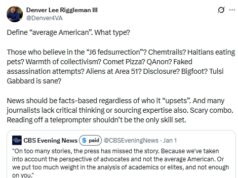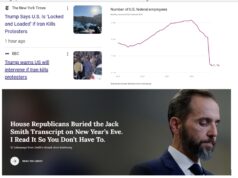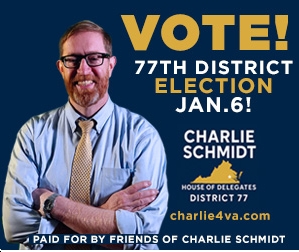 I’ve been arguing for many moons now that in today’s digital age, Democrats need to get away from low-bang-for-the-buck methods like broadcast TV (e.g., “interruption marketing;” should have died out by now for the most part) and towards targeted, high-bang-for-the-buck methods (“permission marketing“). Unfortunately, a lot of Democratic campaigns continue to flush money down the toilet, such as this recent, egregious example from Virginia’s 10th CD. Sigh.
I’ve been arguing for many moons now that in today’s digital age, Democrats need to get away from low-bang-for-the-buck methods like broadcast TV (e.g., “interruption marketing;” should have died out by now for the most part) and towards targeted, high-bang-for-the-buck methods (“permission marketing“). Unfortunately, a lot of Democratic campaigns continue to flush money down the toilet, such as this recent, egregious example from Virginia’s 10th CD. Sigh.
On the bright side, at least SOME smart Democratic political operatives have figured out that there are much smarter, more cost-effective, more targeted methods of reaching voters. One of those operatives is Ian Redman, who has racked up several impressive wins in the last couple years at the local level in northern Virginia: e.g., Barbara Kanninen for Arlington School Board on 2014; Katie Cristol for Arlington County Board in 2015; Tannia Talento for Arlington School Board in 2016.
I had a chance to interview Ian about the techniques he used (see below), and thought it was definitely worth passing along. Note that he and I are very much on the same page here. Let’s start with a very smart move Ian made: pushing traffic to an interview Blue Virginia did with Tannia Talento, one in which she came across very positively. Here’s how Ian describes what he did (bolding added by me for emphasis):
One of the things we did for Tannia’s campaign was to run a Facebook ad for the in-depth Blue Virginia article on Tannia’s platform and story. Our website hosted a lot of content, as did our Facebook page, but we weren’t getting the traffic we wanted to the issues sections as people started to pay attention. About three weeks out from the campaign, we put less than $100 behind the ad linking to Blue Virginia, and over the course of eight days, reached over 4,000 people through Facebook and generated around 1,400 total views on the article.
It would be interesting to know how many of the 1,400 or so people who read that interview ended up voting for Talento, given that she received 1,200 total votes (first-place and reallocated) in the “instant runoff voting” Democratic caucus this past weekend. Presumably, the vast majority of people reading the Talento interview would have been interested in the Arlington School Board election, and many if not most would have been likely voters. So there’s that.
Also worth noting is that Talento’s interview received BY FAR the highest number of views of my three interviews for Arlington School Board (my interview with incumbent Nancy Van Doren received just over 500, while my interview with challenger Michael Shea received over 650. Note that neither of the latter campaigns pushed people to their interviews via Facebook advertising, at least to my knowledge.
So, why did Talento’s interview receive so much more readership? My guess is that the inexpensive advertising campaign on Facebook by Talento’s campaign manager, Ian Redman, pushed an extra 800 or so views to his candidate’s interview, above and beyond what Talento’s rivals received. Of course, we don’t know for sure how many of those people ended up voting for Talento, but in an election where only 1,800 TOTAL VOTES were cast, an extra 800 views (and 1,400 total) certainly is not insignificant. Even better, the campaign only cost something like 12 cents per view — can’t get much cheaper than that!
In sum, the $100 the Talento campaign spent to push likely voters to read our interview seems like money VERY well spent and a big “bang for the buck.” Of course, one could argue that we don’t really “know” any of this, but on the other hand we don’t really know for sure whether any other campaign methods – direct mail, radio, TV, newspaper ads, signs, etc. – work either, but we DO know that most of those cost a ton of money, relatively speaking.
So, given that using social media advertising to push potential voters towards positive content about their candidate seems to be such a no-brainer, why wouldn’t every campaign (including local ones) do this? I was talking to another super-smart Democratic campaign operative who actually “gets” this stuff – and uses it – and he remarked that most campaigns are simply clueless about social/digital media. Of course, resources can be an issue, but the cost of Facebook advertising, let’s say, is a lot lower than direct mail, let alone TV or radio. So maybe it’s lack of knowledge? Which, in turn, is an argument for campaigns hiring someone who knows what they’re doing when it comes to digital advertising and social media, more broadly.
Of course, content and narrative (personal and political, positive and negative) matter a lot as well, yet most campaigns neglect those things too. Yet, since ancient times (The Iliad, The Odyssey, the Torah) until today (Game of Thrones, Star Wars, etc), people have followed characters and story lines they’re interested in and emotionally invested in — and it’s probably not much different for U.S. politics in 2016. Stories that grab people can help a lot, but of course people have to KNOW that the characters and stories even exist, which is where marketing comes in. Good content, good marketing, including smart use of social media: seems like a “no brainer,” wouldn’t you say?
Anyway, with that, here are some more thoughts from Ian Redman on using digital and social media optimally for local (or state or even federal, I’d add) political campaigns. Given Ian’s successful track record, I’d say that this advice is well worth listening to!
Context
The basic thought process in campaigns is how to best increase name recognition and turnout given extremely limited time and (usually) extremely limited resources. Local level voters are more difficult to target, reach, and turnout to vote, generally, so this calculation becomes much more difficult. With fewer dollars and fewer volunteers than a larger campaign, voter contact budgets become really important.
Digital and social media advertising provides a much cheaper option for local campaigns than traditional voter contact: such as TV (nearly impossible), radio, or direct mail. Direct Mail can average about $1 per piece of mail, whereas digital and social media advertising averages only a few cents per engagement or view. This allows you to have more content and flexibility when it comes to reaching people.
Real-Life Applications
Tannia Talento’s campaign for Arlington County School Board focused its limited resources on Facebook advertising, which is probably one of the most affordable social media tools for a local campaign. We used our campaign page to push information about her policy points and supporters to likely supporters in Arlington.
Katie Cristol – whose campaign I provided strategic consulting to, and whose digital strategy was run by Andy Kraut, who did a great job! – had a much more aggressive digital media push, spending thousands of dollars on YouTube and Facebook promotion between the primary and general campaigns, using the targeting tools on those platforms to push her message to several thousand people. Cristol was able to target based on YouTube and Facebook’s behavioral and demographic data, as well as by zip code.
Cost-Benefit Analysis
Ultimately, there are upsides and downsides to all mediums, of course. Unlike direct mail, with digital advertising you are not able to target down to the individual voter and, instead, have to rely on demographic and behavioral data to find your targets. However, there are a few digital advertising platforms for political campaigns that allow you to match IP addresses directly to the voter record. DSPolitical just rolled out one such platform.
On the other hand, there are two big upsides to using digital: 1) it allows campaigns to quickly respond to messages or issues that arise; and 2) the content can reach voters within hours, instead of the days it takes with a direct mail campaign. In fact, to create a Facebook ad only takes minutes, and the approval process is similarly very short.
The other upside of digital and social media ads is that they target voters where they spend most of their time, especially when it comes to younger voters. Most people have a Facebook account, view YouTube or surf the internet.
Monetary difference
Direct Mail: Averages around $1/piece depending the size of the piece and universe. Meaning that to reach one voter three times costs roughly $3.
Social Media Advertising: Averages anywhere from $0.15 per engagement or view, depending on the content. Meaning that you can reach 100 times as many voters with that same $3.
IP match Ads: Depending on the size of the budget and universe, I’ve seen smaller universes average about $0.20 per engagement. This means that you can reach a single voter 15 times for that same $3 budget.
These numbers are pulled together from reviewing local mail, digital and social media estimated plans, invoices, and post-campaign analysis for the Arlington area. The exact numbers are probably different in other areas and with other sized universes. But this gives you the general idea.













